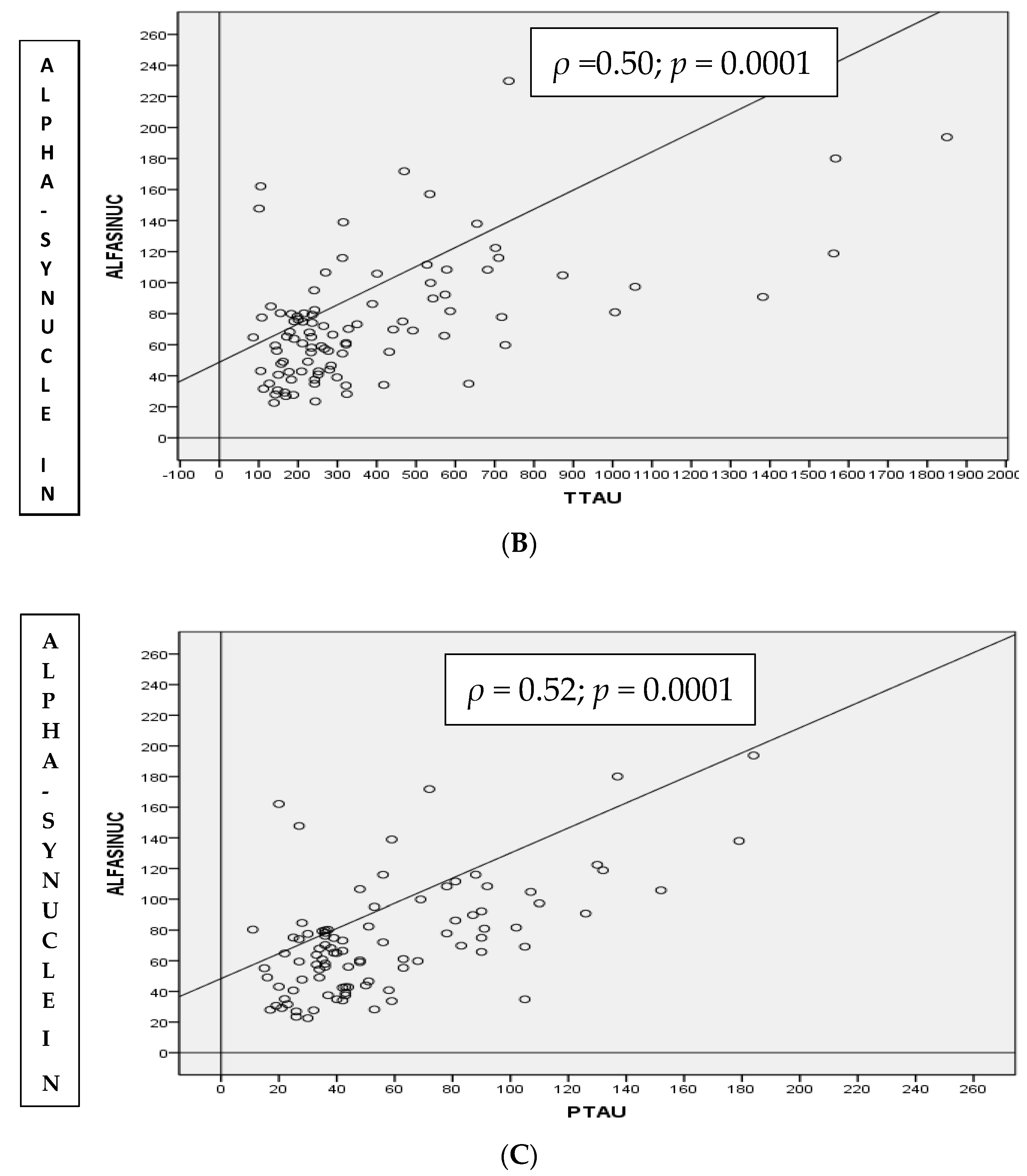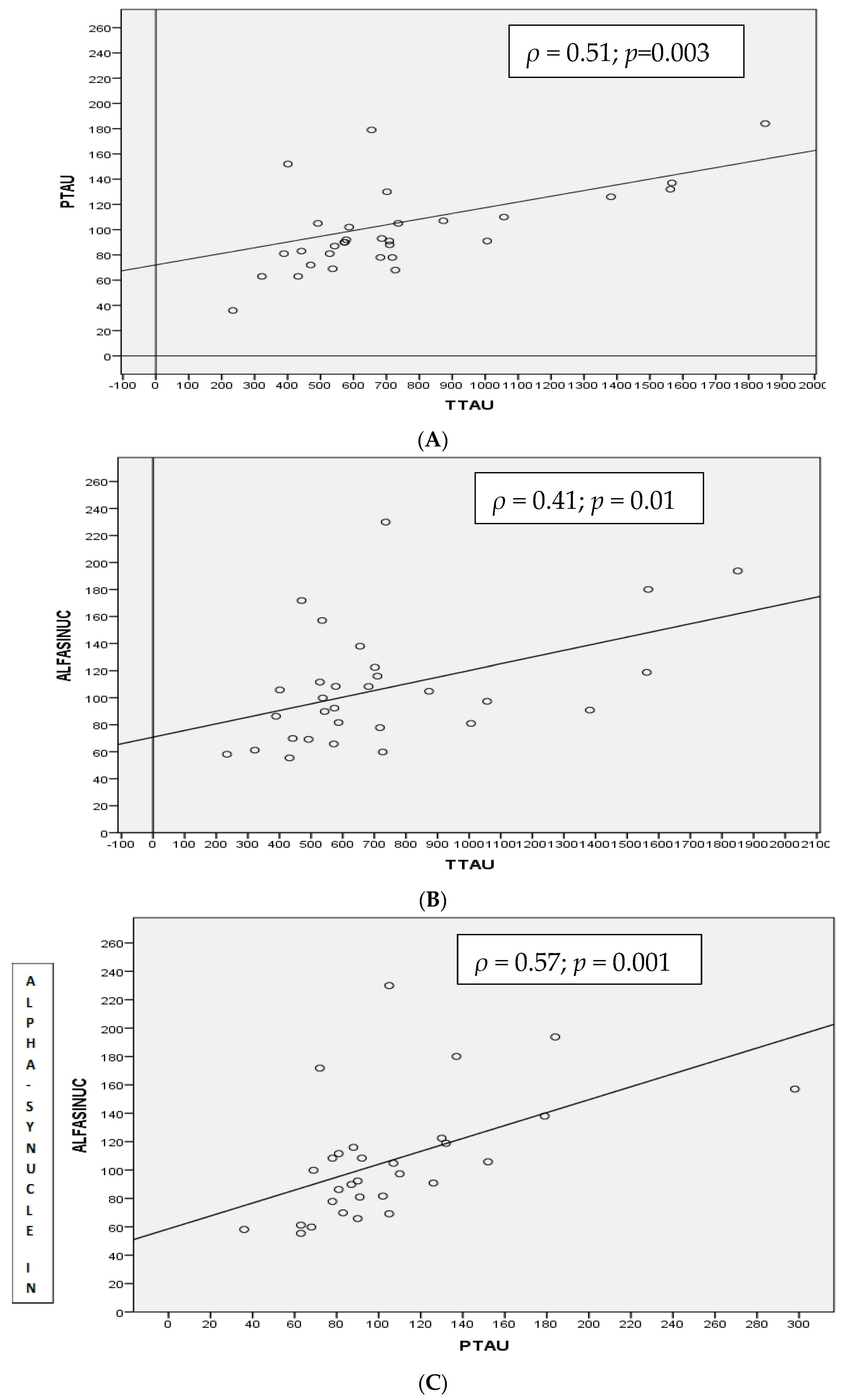Relation between Alpha-Synuclein and Core CSF Biomarkers of Alzheimer’s Disease
Abstract
:1. Introduction
2. Materials and Methods
2.1. Study Design and Participants
2.2. Obtention of CSF
2.3. Measurement of Core AD CSF Biomarkers
2.4. Measurement of CSF α-Synuclein
2.5. Statistical Analysis
2.6. Ethical Criteria
3. Results
3.1. Clinical, Demographic Characteristics and Levels of CSF Biomarkers
3.2. Total Population
3.3. MCI-AD Group
3.4. Control Group
3.5. MCIs Group
3.6. MCI-LBD Group
4. Discussion
5. Conclusions
Author Contributions
Funding
Institutional Review Board Statement
Informed Consent Statement
Data Availability Statement
Acknowledgments
Conflicts of Interest
Abbreviations
References
- Korff, A.; Liu, C.; Ginghina, C.; Shi, M.; Zhang, J. α-Synuclein in Cerebrospinal Fluid of Alzheimer’s Disease and Mild Cognitive Impairment. J. Alzheimer’s Dis. 2013, 36, 679–688. [Google Scholar] [CrossRef] [PubMed] [Green Version]
- Slaets, S.; Vanmechelen, E.; Le Bastard, N.; Decraemer, H.; Vandijck, M.; Martin, J.-J.; De Deyn, P.P.; Engelborghs, S. Increased CSF α-synuclein levels in Alzheimer’s disease: Correlation with tau levels. Alzheimer’s Dement. 2014, 10, S290–S298. [Google Scholar] [CrossRef] [PubMed]
- Berge, G.; Sando, S.B.; Albrektsen, G.; Lauridsen, C.; Møller, I.; Grøntvedt, G.R.; Bråthen, G.; White, L.R. Alpha-synuclein measured in cerebrospinal fluid from patients with Alzheimer’s disease, mild cognitive impairment, or healthy controls: A two year follow-up study. BMC Neurol. 2016, 16, 1–9. [Google Scholar] [CrossRef] [Green Version]
- Llorens, F.; Schmitz, M.; Varges, D.; Kruse, N.; Gotzmann, N.; Gmitterová, K.; Mollenhauer, B.; Zerr, I. Cerebrospinal α-synuclein in α-synuclein aggregation disorders: Tau/α-synuclein ratio as potential biomarker for dementia with Lewy bodies. J. Neurol. 2016, 263, 2271–2277. [Google Scholar] [CrossRef]
- Chiasserini, D.; Biscetti, L.; Eusebi, P.; Salvadori, N.; Frattini, G.; Simoni, S.; De Roeck, N.; Tambasco, N.; Stoops, E.; Vanderstichele, H.; et al. Differential role of CSF fatty acid binding protein 3, α-synuclein, and Alzheimer’s disease core biomarkers in Lewy body disorders and Alzheimer’s dementia. Alzheimer’s Res. Ther. 2017, 9, 1–12. [Google Scholar] [CrossRef]
- Shi, M.; Tang, L.; Toledo, J.; Ginghina, C.; Wang, H.; Aro, P.; Jensen, P.H.; Weintraub, D.; Chen-Plotkin, A.S.; Irwin, D.J.; et al. Cerebrospinal fluid α-synuclein contributes to the differential diagnosis of Alzheimer’s disease. Alzheimer’s Dement. 2018, 14, 1052–1062. [Google Scholar] [CrossRef]
- Wang, H.; Stewart, T.; Toledo, J.B.; Ginghina, C.; Tang, L.; Atik, A.; Aro, P.; Shaw, L.M.; Trojanowski, J.Q.; Galasko, D.R.; et al. A Longitudinal Study of Total and Phosphorylated α-Synuclein with Other Biomarkers in Cerebrospinal Fluid of Alzheimer’s Disease and Mild Cognitive Impairment. J. Alzheimer’s Dis. 2018, 61, 1541–1553. [Google Scholar] [CrossRef] [Green Version]
- Bousiges, O.; Philippi, N.; Lavaux, T.; Perret-Liaudet, A.; Lachmann, I.; Schaeffer-Agalède, C.; Anthony, P.; Botzung, A.; Rauch, L.; Jung, B.; et al. Differential diagnostic value of total alpha-synuclein assay in the cerebrospinal fluid between Alzheimer’s disease and dementia with Lewy bodies from the prodromal stage. Alzheimer’s Res. Ther. 2020, 12, 1–12. [Google Scholar] [CrossRef]
- Shim, K.H.; Kang, M.J.; Suh, J.W.; Pyun, J.-M.; Ryoo, N.; Park, Y.H.; Youn, Y.C.; Jang, J.-W.; Jeong, J.H.; Park, K.W.; et al. CSF total tau/α-synuclein ratio improved the diagnostic performance for Alzheimer’s disease as an indicator of tau phosphorylation. Alzheimer’s Res. Ther. 2020, 12, 1–12. [Google Scholar] [CrossRef]
- Larson, M.E.; Sherman, M.A.; Greimel, S.; Kuskowski, M.; Schneider, J.A.; Bennett, D.A.; Lesné, S.E. Soluble -Synuclein Is a Novel Modulator of Alzheimer’s Disease Pathophysiology. J. Neurosci. 2012, 32, 10253–10266. [Google Scholar] [CrossRef] [Green Version]
- Clinton, L.K.; Blurton-Jones, M.; Myczek, K.; Trojanowski, J.Q.; LaFerla, F.M. Synergistic Interactions between Aβ, Tau, and -Synuclein: Acceleration of Neuropathology and Cognitive Decline. J. Neurosci. 2010, 30, 7281–7289. [Google Scholar] [CrossRef] [PubMed] [Green Version]
- Vergallo, A.; Bun, R.-S.; Toschi, N.; Baldacci, F.; Zetterberg, H.; Blennow, K.; Cavedo, E.; Lamari, F.; Habert, M.-O.; Dubois, B.; et al. Association of cerebrospinal fluid α-synuclein with total and phospho-tau181protein concentrations and brain amyloid load in cognitively normal subjective memory complainers stratified by Alzheimer’s disease biomarkers. Alzheimer’s Dement. 2018, 14, 1623–1631. [Google Scholar] [CrossRef] [PubMed] [Green Version]
- Toledo, J.B.; Korff, A.; Shaw, L.M.; Trojanowski, J.Q.; Zhang, J. CSF α-synuclein improves diagnostic and prognostic performance of CSF tau and Aβ in Alzheimer’s disease. Acta Neuropathol. 2013, 126, 683–697. [Google Scholar] [CrossRef] [PubMed] [Green Version]
- Artero, S.; Petersen, R.; Touchon, J.; Ritchie, K. Revised criteria for mild cognitive impairment: Validation within a longitudinal population study. Dement. Geriatr. Cogn. Disord. 2006, 22, 465–470. [Google Scholar] [CrossRef] [PubMed] [Green Version]
- McKhann, G.M.; Knopman, D.S.; Chertkow, H.; Hyman, B.T.; Jack, C.R., Jr.; Kawas, C.H.; Klunk, W.E.; Koroshetz, W.J.; Manly, J.J.; Mayeux, R.; et al. The diagnosis of dementia due to Alzheimer’s disease: Recommendations from the National Institute on Aging-Alzheimer’s Association workgroups on diagnostic guidelines for Alzheimer’s disease. Alzheimer’s Dement. 2011, 7, 263–269. [Google Scholar] [CrossRef] [PubMed] [Green Version]
- McKeith, I.G.; Dickson, D.W.; Lowe, J.; Emre, M.; O’Brien, J.; Feldman, H.; Cummings, J.; Duda, J.E.; Lippa, C.; Perry, E.K.; et al. Diagnosis and management of dementia with Lewy bodies: Third report of the DLB consortium. Neurology 2005, 65, 1863–1872. [Google Scholar] [CrossRef] [Green Version]
- Jack, C.R., Jr.; Bennett, D.A.; Blennow, K.; Carrillo, M.C.; Dunn, B.; Haeberlein, S.B.; Holtzman, D.M.; Jagust, W.; Jessen, F.; Karlawish, J.; et al. NIA-AA Research Framework: Toward a biological definition of Alzheimer’s disease. Alzheimer’s Dement. 2018, 14, 535–562. [Google Scholar] [CrossRef]
- Kruse, N.; Persson, S.; Alcolea, D.; Bahl, J.M.; Baldeiras, I.; Capello, E.; Chiasserini, D.; Chiavetto, L.B.; Emersic, A.; Engelborghs, S.; et al. Validation of a quantitative cerebrospinal fluid alpha-synuclein assay in a European-wide interlaboratory study. Neurobiol. Aging 2015, 36, 2587–2596. [Google Scholar] [CrossRef]
- García-Ayllón, M.; Monge-Argilés, J.; Monge-García, V.; Navarrete, F.; Cortés-Gómez, M.; Sánchez-Payá, J.; Manzanares, J.; Gasparini-Berenguer, R.; Leiva-Santana, C.; Sáez-Valero, J. Measurement of CSF α-synuclein improves early differential diagnosis of mild cognitive impairment due to Alzheimer’s disease. J. Neurochem. 2019, 150, 218–230. [Google Scholar] [CrossRef] [Green Version]
- Pace, M.C.; Xu, G.; Fromholt, S.; Howard, J.; Crosby, K.; Giasson, B.I.; Lewis, J.; Borchelt, D.R. Changes in proteome solubility indicate widespread proteostatic disruption in mouse models of neurodegenerative disease. Acta Neuropathol. 2018, 136, 919–938. [Google Scholar] [CrossRef]
- Duka, T.; Sidhu, A. The neurotoxin, MPP+, induces hyperphosphorylation ofTau, in the presence of α-Synuclein, in SH-SY5Y neuroblastoma cells. Neurotox. Res. 2006, 10, 1–10. [Google Scholar] [CrossRef]
- Giasson, B.I.; Forman, M.S.; Higuchi, M.; Golbe, L.I.; Graves, C.L.; Kotzbauer, P.T.; Trojanowski, J.Q.; Lee, V.M.-Y. Initiation and Synergistic Fibrillization of Tau and Alpha-Synuclein. Science 2003, 300, 636–640. [Google Scholar] [CrossRef] [PubMed] [Green Version]
- Msc, I.V.S.; Majbour, N.; Msc, N.N.V.; Berendse, H.W.; Van Der Flier, W.M.; van de Berg, W.; Teunissen, C.E.; Lemstra, A.W.; El-Agnaf, O.M. α-Synuclein species as potential cerebrospinal fluid biomarkers for dementia with lewy bodies. Mov. Disord. 2018, 33, 1724–1733. [Google Scholar] [CrossRef] [Green Version]
- Yiannopoulou, K.G.; Papageorgiou, S.G. Current and Future Treatments in Alzheimer Disease: An Update. J. Central Nerv. Syst. Dis. 2020, 12, 117957352090739. [Google Scholar] [CrossRef] [Green Version]



| Control | Stable MCI | LBD | AD | p Value | |
|---|---|---|---|---|---|
| Number | 18 | 25 | 24 | 32 | ----- |
| Age (mean ± SD) | 67.3 ±5.7 | 70.5 ± 7.3 | 74.7 ± 5.8 | 71.3 ± 7.3 | 0.007 |
| Males (%) | 8 (44) | 12 (48) | 12 (50) | 12 (37.5) | 0.7 |
| Antecedents (%): | |||||
| Diabetes | 7 (39) | 5 (20) | 3 (12) | 6 (19) | 0.06 |
| Hypertension | 11 (61) | 14 (56) | 15 (62) | 15 (47) | 0.8 |
| Hyperlipidemia | 14 (77) | 18 (72) | 11 (45) | 14 (44) | 0.07 |
| Depression | 8 (44) | 18 (72) | 13 (54) | 15 (47) | 0.06 |
| Schooling years (mean ± SD) | 4.5 ± 1.2 | 4.6 ± 1.2 | 3.8 ± 1.1 | 4.1 ± 0.9 | 0.7 |
| Start of the symptoms before LP months (mean ± SD) | -------- | 19 ± 15 | 31 ± 18 | 18 ± 7 | 0.06 |
| MMSE (mean ± SD) | 27.5 ± 1.2 | 25.6 ± 1.6 | 24.5 ± 2.0 | 24.2 ± 2.4 | 0.5 |
| IQCODE (mean ± SD) | -------- | 62.0 ± 8.6 | 68.7 ± 9.9 | 70.0 ± 7.6 | 0.08 |
| NPI (mean ± SD) | ------- | 10.6 ± 2.5 | 9.1 ± 2.0 | 10.3 ± 1.9 | 0.8 |
| Clinical follow-up after LP months (mean ± SD) | 39 ± 21.6 | 80 ± 22 | 41 ± 33 | 41 ± 29 | 0.01 |
| Amnestic/non amnestic MCI | ------- | 14/11 | 5/19 | 25/2 | MCI/LBD: 0.5 MCI/AD: 0.01 AD/LBD: 0.01 |
| MRI-MTA (mean ± SD) | 1.1 ± 1.5 | 3.5 ± 1.1 | 3.7 ± 1.2 | 4.3 ± 1.5 | 0.01 |
| Aβ1–42 levels (pg/mL) median [p25-p-75] | 1274 [1139–1410] | 925 [772–1078] | 612 [436–743] | 499 [430–583] | MCI/MCI-LBD: <0.001 MCI/MCI-AD: <0.001 MCI-AD/MCI-LBD: n.s. |
| T-tau levels (pg/mL) median [p25-p-75] | 212 [171–236] | 225 [157–282] | 243 [159–292] | 621 [510–732] | MCI/MCI-LBD: n.s. MCI/MCI-AD: <0.001 MCI-AD/MCI-LBD: <0.001 |
| p-tau181p levels (pg/mL) median [p25-p-75] | 37 [34–40] | 34 [27–42] | 42 [25–52] | 91 [80–118] | MCI/MCI-LBD: n.s. MCI/MCI-AD: <0.001 MCI-AD/MCI-LBD: <0.001 |
| α-syn levels (pg/mL) median [p25-p-75] | 1914 [1626–2664] | 1505 [1219–1915] | 936 [736–1121] | 2557 [1985–3255] | MCI/MCI-LBD: <0.001 MCI/MCI-AD: <0.001 MCI-AD/MCI-LBD: <0.001 |
Publisher’s Note: MDPI stays neutral with regard to jurisdictional claims in published maps and institutional affiliations. |
© 2021 by the authors. Licensee MDPI, Basel, Switzerland. This article is an open access article distributed under the terms and conditions of the Creative Commons Attribution (CC BY) license (https://creativecommons.org/licenses/by/4.0/).
Share and Cite
Monge-García, V.; García-Ayllón, M.-S.; Sáez-Valero, J.; Sánchez-Payá, J.; Navarrete-Rueda, F.; Manzanares-Robles, J.; Gasparini-Berenguer, R.; Romero-Lorenzo, R.; Cortés-Gómez, M.A.; Monge-Argilés, J.-A. Relation between Alpha-Synuclein and Core CSF Biomarkers of Alzheimer’s Disease. Medicina 2021, 57, 954. https://doi.org/10.3390/medicina57090954
Monge-García V, García-Ayllón M-S, Sáez-Valero J, Sánchez-Payá J, Navarrete-Rueda F, Manzanares-Robles J, Gasparini-Berenguer R, Romero-Lorenzo R, Cortés-Gómez MA, Monge-Argilés J-A. Relation between Alpha-Synuclein and Core CSF Biomarkers of Alzheimer’s Disease. Medicina. 2021; 57(9):954. https://doi.org/10.3390/medicina57090954
Chicago/Turabian StyleMonge-García, Victoria, María-Salud García-Ayllón, Javier Sáez-Valero, José Sánchez-Payá, Francisco Navarrete-Rueda, Jorge Manzanares-Robles, Ruth Gasparini-Berenguer, Raquel Romero-Lorenzo, María Angeles Cortés-Gómez, and José-Antonio Monge-Argilés. 2021. "Relation between Alpha-Synuclein and Core CSF Biomarkers of Alzheimer’s Disease" Medicina 57, no. 9: 954. https://doi.org/10.3390/medicina57090954
APA StyleMonge-García, V., García-Ayllón, M.-S., Sáez-Valero, J., Sánchez-Payá, J., Navarrete-Rueda, F., Manzanares-Robles, J., Gasparini-Berenguer, R., Romero-Lorenzo, R., Cortés-Gómez, M. A., & Monge-Argilés, J.-A. (2021). Relation between Alpha-Synuclein and Core CSF Biomarkers of Alzheimer’s Disease. Medicina, 57(9), 954. https://doi.org/10.3390/medicina57090954








